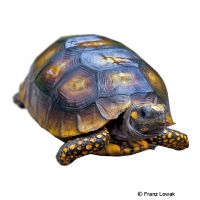Yellow-footed Tortoise (Chelonoidis denticulatus)
| Yellow-footed Tortoise Chelonoidis denticulatus | |
|---|---|
| Name | Yellow-footed Tortoise |
| Name Lat. | Chelonoidis denticulatus |
| Synonym | Geochelone denticulata |
| Family | Tortoises |
| Family lat. | Testudinidae |
| Order | Turtles |
| Order lat. | Testudines |
| Origin | NSouth America |
| Habitat | Rainforests |
| Diet | Herbs, veggies, insects |
| Humidity | 70-90 % |
| Behavior | Peaceful |
| Keeping | Individual, pair |
| Care Level | Moderate |
| Reproduction | Oviparous |
| Housing | Semi-humid terrarium |
| Life Span | 25-30 years |
| Protection | CITES Appendix II; EU Annex B |
| Metric Units | |
| Size | 40-60 cm |
| Temperature | 25-30 °C |
| Temperature Local | 35-40 °C |
| Housing Size | 400 x 200 x 100 m |
| US Units | |
| Size | 16"-24" |
| Temperature | 77-86 °F |
| Temperature Local | 95-104 °F |
| Housing Size | 155" x 80" x 40" |
Distribution and habitat
The distribution area of the forest tortoises is the tropical South America from Panama to the north of Argentina. There they live in the humid rainforest. Grasslands and open areas of the rainforests are avoided.
Maintenance
Minimum dimensions for the terrarium, according to the size and number of animals
| 1-2 animals | 8PL x 4PL (L x W) |
The carapace length (PL) is measured on the largest animal. For each additional animal the footprint has to be increased by10 %, from the 5th animal on by 20 %. A terrarium of e.g.400 x 200 x 100 cm is recommended, which should be placed in a quiet and vibration-free place.
You need a terrarium structured with roots, robust plants and stones with a graveable substrate, e.g. of earth-peat mixture, as well as an easy to clean, large water basin, approx. 20 cm deep. The substrate should always be kept slightly moist. In case of group keeping, suitable, separate retreats should be provided. Mhermals daily the inside of the terrarium should be finely sprayed with water (humidity). A rain or mist system is ideal.
| Temp. day: 25-30 °C | Temp. night: 20-25 °C | Temp. local: 35-40 °C | Humidity: 70-90 % |
Thermostatically controlled floor heating is recommended. Lighting duration must be 10-14 hrs, depending on the season. They need high light intensity and daily UV irradiation as well as sunny places with radiant heat.
Diet
They are omnivores, but they feed almost exclusively vegetarian. The diet consists of a wide range of wild herbs (plantain, dandelion, parsley, etc.), grass, hay and hay dressings, clover, sweet grasses, mushrooms and vegetables such as lettuce, spinach, cabbage leaves, cucumbers, zucchini and carrots, supplemented with commercial ready-made food for tortoises. Occasionally they need animal protein, such as earthworms, snails or grasshoppers, and small pieces of hard-boiled egg. Fruit should be fed sparingly and infrequently because of the fructose content. Regular addition of minerals and vitamins is important. Clean drinking water (drunk through the nose) must always be available
A varied diet promotes health and prevents deficiency symptoms.
Reproduction and breeding
Males grow significantly larger, have a concave ventral carapace (plastron) and a much longer tail. Mating occurs year-round, but cooler months are preferred. Egg laying occurs 2-3 times a year. The female buries her eggs, a maximum of 5 per clutch, about 15 cm deep in a south-facing spot. The incubation period is 130-150 days at about 30 °C. The life expectancy can be 25-30 years.
Species protection
The animal population must be reported in writing to the competent authority immediately after the start of keeping. Subsequently, all arrivals and departures must be reported.
Protection of species: WA Annex II; EU Annex B. The proof of purchase is the required proof of origin for the animal. Please keep it safe! Your pet store will be happy to provide you with further information.
Important
Paired, relatively large scales on the top of the head just behind the nose are characteristic
They are active all year round and do not hibernate in the conventional sense, but frequently take rest periods during the summer. Free-range housing is advised during the summer months, and a heated retreat must be available. The temperature must not drop below 20 °C for a longer period of time, as the animals easily get chilled.
The terrarium must have good ventilation without drafts and meet the species-specific needs. Measuring devices such as thermometers, hygrometers, etc. are necessary. The lighting has to correspond to the species-specific day-night rhythm and has to be placed in such a way that the animals cannot injure themselves. The terrarium should be locked in such a way that neither unauthorized persons can open it nor the animals can escape. Contamination must be removed regularly
Further literature can be found in your pet store.
References
Text: Christian Sänger; Image: Franz Lowak
Source: BMELV (1997): Tierschutzgutachten - Mindestanforderungen an die Haltung von Reptilien; ENGELMANN (2006): Zootierhaltung - Tiere in menschlicher Obhut: Reptilien und Amphibien, Harri Deutsch Verlag
- Gemäß § 21 Abs. 5 Tierschutzgesetz idgF
